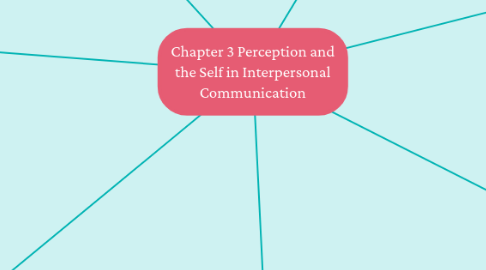
1. Impression Formation Processes
1.1. Self-Fulfilling Prophecy
1.1.1. Prediction that comes true because you act on it as if it true
1.2. Implicit Personality Theory
1.2.1. Characteristics of an individual go with other characteristics
1.2.2. Halo effect - function of the implicit personality theory
1.2.3. Reverse halo effect - a person possesses several negative qualities
1.3. Perception Accentuation
1.3.1. Leads you to see what you expect or want to see
1.3.2. Lead you to perceive what you need or want to perceive rather than what is really there, and fail to perceive what you don't want to perceive
1.4. Primacy-Recency
1.4.1. First Impression Most Important
1.4.2. Subsequent Data Discounted
1.5. Consistency
1.5.1. The tendency to maintain balance among perceptions or attitudes
1.5.2. Excepted response
1.5.2.1. I expect a person I like to (like, dislike) me
1.5.2.2. I expect a person I dislike to (like, dislike) me
1.5.2.3. I expect my friend to (like, dislike) my friend
1.5.2.4. I expect my friend to (like, dislike) my enemy
1.6. Attribution of Control
1.6.1. Negative Behavior
1.6.1.1. Attribute motives for behavior depending upon belief of other’s ability to control situation
1.6.2. Attribution Error
1.6.2.1. Self-serving bias
1.6.2.2. Overattribution
1.6.2.3. Fundamental attribution error
2. Increasing Accuracy in Impression Formation
2.1. Analyze Impressions
2.1.1. Recognize your own role in perception
2.1.2. Avoid early conclusions
2.2. Check Perceptions
2.2.1. Describe what you see or hear
2.2.2. Seek Information
2.3. Reduce Uncertainty
2.3.1. Observe another person
2.3.2. Manipulate situations
2.3.3. Log on to an internet chat group and lurk
2.3.4. Asking others
2.3.5. Interact with the individual
3. Impression Management
3.1. Goals and Strategies
3.1.1. Immediacy
3.1.2. Affinity-seeking
3.1.3. Politeness strategies
3.1.4. Credibility strategies
3.1.5. Self-handicapping strategies
3.1.6. Self-monitoring strategies
3.1.7. Self-monitoring strategies
3.1.8. Influencing strategies
3.1.9. Image-confirming strategies
4. Self-Concept
4.1. Self Concept
4.2. Social Comparisons
4.3. Your Interpretations and Evaluations
4.4. Cultural Teachinfs
5. Self-Awareness
5.1. The Johari Window
5.1.1. Open Self
5.1.2. Blind Self
5.1.3. Hidden Self
5.1.4. Unknown Self
5.2. Increasing self-awareness
5.2.1. Listen to others
5.2.2. Actively seek information about yourself
5.2.3. See your different selves
5.2.4. Increase your open self
6. Self-Esteem
6.1. Attack Self-Destructive Beliefs
6.2. Seek Out Nourishing People
6.3. Work on Projects That Will Result in Success
6.4. Remind Yourself of Your Successes
6.5. Secure Affirmation
7. Perception
7.1. The process by which you become aware of objects, events, and especially people through your sense: sight, smell, taste, touch, and hearing.
7.2. Stages of Perception
7.2.1. Stage 1
7.2.1.1. Selective attention
7.2.1.2. Selective exposure
7.2.2. Stage 2
7.2.2.1. Organization
7.2.2.1.1. Rules
7.2.2.1.2. Schemata
7.2.2.1.3. Scripts
7.2.3. Stage 3
7.2.3.1. Interpretation-Evaluation
7.2.3.1.1. greatly influenced by experiences, needs, wants, values, and beliefs about the way things are or should be: expectations, physical and emotional state: and so on
7.2.4. Stage 4
7.2.4.1. Memory
7.2.4.1.1. cognitive tag
7.2.5. Stage 5
7.2.5.1. Recall
7.2.5.1.1. involves accessing the information you have stored in memory
7.2.5.1.2. depending in great part on your schemata and scripts
7.2.5.1.3. recall information that is consistent with your schema
7.2.5.1.4. recall information that is inconsistent with your schema
7.2.5.1.5. recall information that drastically contradicts your schema
